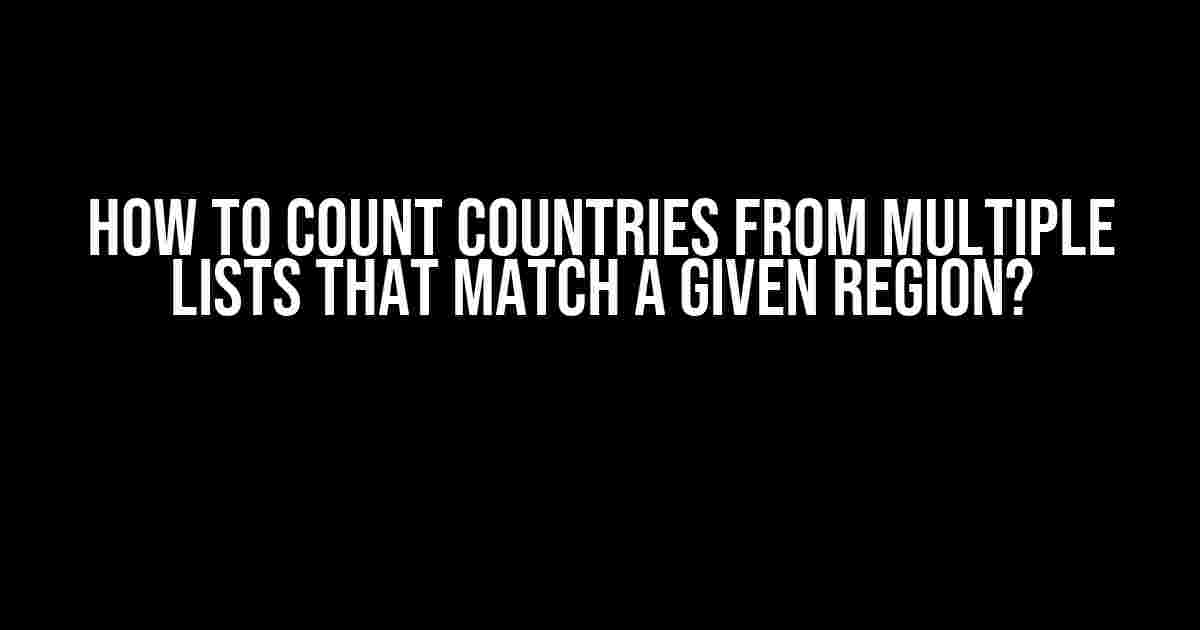Are you tired of manually going through list after list, trying to count the countries that match a specific region? Well, put down that magnifying glass and step away from the spreadsheets! In this article, we’ll show you how to count countries from multiple lists that match a given region, and it’s easier than you think!
Why Do We Need to Count Countries by Region?
Counting countries by region is a crucial task in various fields, including business, research, and education. Imagine you’re a market researcher trying to understand consumer behavior in different parts of the world. Or, you’re a geography teacher trying to help your students visualize the world’s countries and their respective regions. Whatever the case, counting countries by region helps us make sense of the world and make informed decisions.
What We’ll Cover in This Article
In this article, we’ll break down the process of counting countries from multiple lists that match a given region into manageable chunks. We’ll cover the following topics:
- Preparing your data
- Using lists to count countries
- Matching countries to regions
- Counting countries using formulas
- Visualizing your results
Preparing Your Data
Before we dive into the counting process, let’s get our data in order. You’ll need two lists: one containing the countries, and another containing the regions. Let’s assume you have two tables, `Countries` and `Regions`, with the following structures:
| Table: Countries | |
|---|---|
| Country | Code |
| Afghanistan | AFG |
| Albania | ALB |
| Table: Regions | |
|---|---|
| Region | Countries |
| Asia | Afghanistan, China, India |
| Europe | Albania, France, Germany |
Using Lists to Count Countries
Now that we have our data, let’s create a list to store the countries that match a given region. We’ll use Google Sheets or Microsoft Excel for this example, but you can use any spreadsheet software you prefer.
=FILTER(Countries!A:A, REGEXMATCH(Countries!A:A,Regions!B:B))
This formula filters the `Countries` table to show only the countries that match the region specified in the `Regions` table. The `REGEXMATCH` function checks if the country name is present in the `Countries` column of the `Regions` table.
Matching Countries to Regions
To match countries to regions, we’ll create a separate column in the `Countries` table that indicates the region each country belongs to. We’ll use the `VLOOKUP` function for this:
=VLOOKUP(A2, Regions!A:B, 2, FALSE)
This formula looks up the country code in column `A` of the `Countries` table and returns the corresponding region from column `B` of the `Regions` table.
Counting Countries Using Formulas
Now that we have our countries matched to regions, it’s time to count them! We’ll use the `COUNTIFS` function to count the number of countries that match a given region:
=COUNTIFS(Countries!C:C, "Asia")
This formula counts the number of countries in column `C` (the region column) that match the region “Asia”. You can replace “Asia” with any region you want to count.
Visualizing Your Results
Finally, let’s visualize our results to get a better understanding of the data. We can create a bar chart or a pie chart to show the number of countries in each region:
=BAR_CHART(Countries!C:C, Regions!A:A)
This formula creates a bar chart with the regions on the x-axis and the number of countries on the y-axis. You can customize the chart to your liking and even add more visualizations to gain deeper insights.
Conclusion
Counting countries from multiple lists that match a given region is a daunting task, but with the right tools and formulas, it becomes a breeze! By following the steps outlined in this article, you’ll be able to efficiently count countries by region and gain valuable insights from your data.
Remember to adapt the formulas and techniques to your specific use case, and don’t hesitate to reach out if you have any questions or need further assistance. Happy counting!
Bonus Tips and Tricks
Here are some additional tips and tricks to help you count countries like a pro:
- Use named ranges to make your formulas more readable and maintainable.
- Consider using a pivot table to summarize your data and create custom views.
- Use conditional formatting to highlight countries that belong to a specific region.
- Experiment with different chart types to visualize your data in unique and creative ways.
FAQs
Here are some frequently asked questions about counting countries from multiple lists that match a given region:
- Q: Can I use this method for counting cities or states instead of countries?
A: Yes, you can modify the formulas to work with cities or states by updating the tables and lists accordingly. - Q: What if I have multiple regions with the same name?
A: You can use the `UNIQUE` function to remove duplicates and ensure accurate counting. - Q: How do I handle countries that belong to multiple regions?
A: You can use the `IF` function to create a custom logic for handling countries that belong to multiple regions.
Final Thoughts
Counting countries from multiple lists that match a given region is a powerful skill that can open up new possibilities for data analysis and visualization. By mastering this technique, you’ll be able to unlock hidden insights and make more informed decisions in your personal and professional life. So go ahead, get counting, and watch your data come alive!
Frequently Asked Question
Get ready to embark on a thrilling adventure of counting countries from multiple lists that match a given region! Buckle up and let’s dive into the FAQs that’ll help you navigate this exciting journey!
What’s the easiest way to count countries from multiple lists that match a given region?
One simple approach is to use the `INTERSECT` operator in SQL or a similar function in your preferred programming language. This allows you to combine multiple lists and retrieve only the countries that appear in all of them, matching your desired region.
How do I handle cases where country names are spelled differently across lists?
Ah-ha! This is a great question! To tackle this challenge, you can use fuzzy matching techniques, such as the `SOUNDEX` or `LEVENSHTEIN` functions, to account for minor variations in country names. These functions will help you match countries with similar names, ensuring a more accurate count.
What if I need to count countries that belong to multiple regions?
No worries! In this case, you can use a combination of `UNION` and `INTERSECT` operators to identify countries that appear in multiple lists, each corresponding to a specific region. This will give you a comprehensive count of countries across all regions.
Can I use programming languages like Python or R for this task?
Absolutely! Python and R are excellent choices for counting countries from multiple lists. You can leverage libraries like `pandas` in Python or `dplyr` in R to perform set operations, merge datasets, and apply filters to get the desired count. These languages offer a wide range of data manipulation and analysis tools to make your task easier and more efficient.
How do I ensure the accuracy of my country count, especially when dealing with incomplete or outdated data?
Excellent question! To ensure accuracy, it’s crucial to validate your data sources and lists. Verify the country names against reputable sources like the ISO 3166 standard or the United Nations’ list of countries. Additionally, consider implementing data quality checks, such as removing duplicates, handling null values, and performing data normalization. By doing so, you’ll increase the reliability of your country count and make informed decisions.


